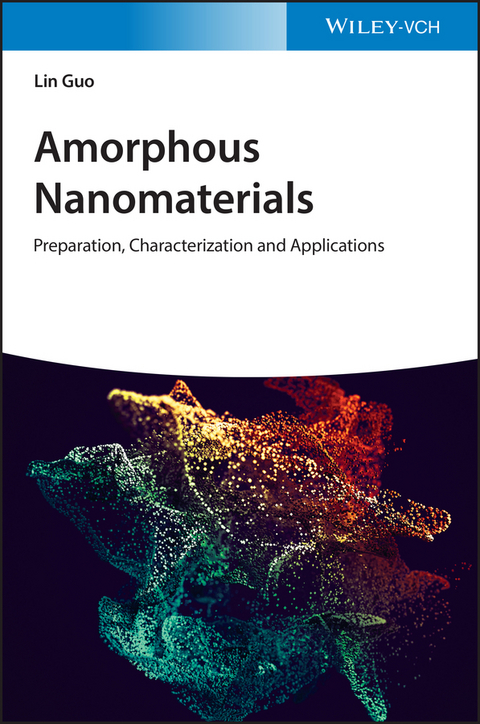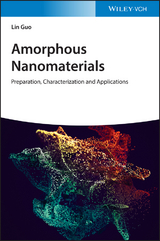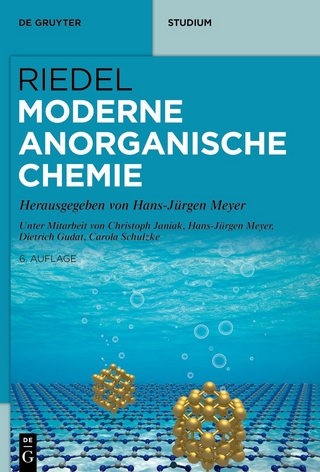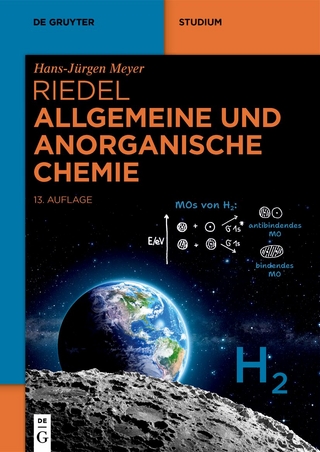Amorphous Nanomaterials
Wiley-VCH (Verlag)
978-3-527-34747-6 (ISBN)
Lin Guo, Professor, is the executive dean of school of chemistry, Beihang University, China. He has received several scientific awards include the Humboldt Fellowship Award, Germany in 2001, the Outstanding Youth Fund from Nature Science Foundation of China in 2007, the Yangtze River Scholars Distinguished Professor in 2011, Prize of National Natural Science of China in 2013. Also, he is the Fellow of the Royal Society Chemistry in 2015. His research interests focus on synthesis, characterization, and applications of zero-, one, two and three-dimensional nanomaterials. He has published more than 280 peer-reviewed articles till now.
Chapter 1 Introduction
1.1 Introduction of Amorphous Material
1.2 Structural Differences of Amorphous Material and Crystal
1.3 History of the Amorphous Materials
1.4 Growth Mechanism of Amorphous Nanomaterials
References
Chapter 2 Local Structure and Electronic State of Amorphous Nanomaterials
2.1 Spherical Aberration Corrected Transmission Electron Microscopy
2.1.1 Introduction
2.1.2 Spherical Aberration Corrected Transmission Electron Microscopy
2.1.3 Electron Energy-loss Spectroscopy in the TEM
2.1.4 Characterization of Amorphous Materials by Using In-situ TEM with Aberration Corrector
2.1.5 Summary and Outlook
2.2 X-ray Absorption Fine Structure Spectrum
2.2.1 Introduction
2.2.2 Extended X-ray Absorption Fine Structure
2.2.3 X-ray Absorption Near Edge Structure
2.2.4 Application in Amorphous Nanomaterials
2.2.5 Summary and Outlooks
References
Chapter 3 Defect Characterization of Amorphous Nanomaterials
3.1 Introduction
3.2 Defect Identification in Semiconductors with PAS
3.3 Defect Analysis in Nanomaterials by EPR
3.4 Defect Activated PL Spectroscopy
References
Chapter 4 The Synthesis Methods of 0D Amorphous Nanomaterials
4.1 Introduction
4.2 The Bottom-up Approach
4.3 The Top-down Approach
4.4 Summary and Outlook
References
Chapter 5 The Synthesis Methods of 1D Amorphous Nanomaterials
5.1 Introduction
5.2 The Synthesis Methods of 1D Amorphous Nanomaterials
5.2.1 Hydrothermal/Solvothermal Method
5.2.2 Chemical Precipitation Method
5.2.3 Electrochemical Deposition Method
5.2.4 Templating Method
5.2.5 Other Synthetic Methods
5.3 Summary and Outlook
References
Chapter 6 The Synthesis Methods of 2D Amorphous Nanomaterials
6.1 Introduction
6.2 Thermal Decomposition Method
6.3 Exfoliation Method
6.4 Deposition Method
6.4.1 Physical Vapor Deposition Method
6.4.2 Electrodeposition Method
6.5 Chemical Precipitation Method
6.6 Template Method
6.7 Phase Transformation Method
6.8 Sol-Gel Method
6.9 Element Doping Method
6.10 Summary and Outlook
References
Chapter 7 Synthesis of 3D Amorphous Nanomaterials
7.1 Introduction
7.2 Template-Engaged Strategies
7.2.1 Coordinating Etching Method
7.2.2 Acid/Alkali Etching Method
7.2.3 Redox Etching Method
7.2.4 Self-Templated Method
7.3 Electrochemical Method
7.4 Hydrothermal/Solvothermal Method
7.5 Common Solution Method
7.6 Laser/Ultrasonic-Assisted Solution Method
7.7 Other Special Strategies
7.8 Conclusions and Outlook
References
Chapter 8 Amorphous Coated and Amorphous Doped or Hybrid Nanomaterials
8.1 Introduction
8.2 Amorphous Coated Nanomaterial by Atomic Layer Deposition
8.2.1 Amorphous Metal Oxide Thin Film Coating
8.2.2 Other Amorphous Thin Film Coating
8.3 Amorphous/Crystalline Structural Nanomaterials
8.3.1 1D Amorphous Coated Nanomaterials
8.3.1.1 Crystalline-Amorphous Homojunction Nanostructure
8.3.1.2 Crystalline-Amorphous Heterojunction Nanostructure
8.3.2 2D Amorphous Coated Nanomaterials
8.3.2.1 Carbon-based 2D Nanostructure
8.3.2.2 Amorphous Nanosheets on Ni Foam
8.3.2.3 Amorphous Metal Compounds Nanoplates
8.3.3 3D Amorphous Coated Nanomaterials
8.3.3.1 Silica Coating
8.3.3.2 Carbon Coating
8.3.3.3 Metal Oxide Coating
8.3.3.4 Metal Sulfide Coating
8.4 Amorphous Doped or Hybrid Nanomaterials
8.4.1 2D Amorphous Doped or Hybrid Crystalline Nanomaterials
8.4.2 3D Amorphous Doped or Hybrid Crystalline Nanomaterial
8.4.2.1 Two-Phase Metal Oxide Structure
8.4.2.2 Hollow Structure
8.5 Conclusion and Outlook
Reference
Chapter 9 The Application of Amorphous Nanomaterials in Electrocatalysis
9.1 Introduction
9.2 Fundamentals of Electrocatalysis and the Roles of Catalysts
9.3 Amorphous Materials as Electrocatalysts for Water Splitting
9.3.1 Amorphous Electrocatalysts for HER
9.3.1.1 Amorphous Single Metallic Compounds for HER
9.3.1.2 Amorphous Binary Metallic Compounds for HER
9.3.1.3 Amorphous Composites for HER
9.3.2 Amorphous Electrocatalysts for OER
9.3.2.1 Amorphous Single Metallic Compounds for OER
9.3.2.2 Amorphous Binary Metallic Compounds for OER
9.3.2.3 Amorphous Single Polynary Compounds for OER
9.3.2.4 Amorphous Composite for OER
9.3.3 Amorphous Electrocatalysts for ORR
9.3.3.1 Amorphous Noble Metal Based Materials for ORR
9.3.3.2 Amorphous 3d Metal Based Materials for ORR
9.3.4 Amorphous Electrocatalysts for CRR
9.3.5 Amorphous Electrocatalysts for NER
9.3.6 Amorphous Compounds as Bifunctional
Electrocatalysts
9.3.6.1 Amorphous Compounds as Bifunctional Electrocatalysts of HER&OER
9.3.6.2 Amorphous Compounds as Bifunctional Electrocatalysts of ORR&OER
9.4 Summary and Outlook
References
Chapter 10 The Application of Amorphous Nanomaterials in Batteries
10.1 Introduction
10.2 Negative Electrodes in Cells
10.2.1 Phosphorus Compounds
10.2.2 Silicon Compounds
10.2.3 Transition Metal Oxides
10.2.3.1 Iron Oxides
10.2.3.2 Titanium Oxides
10.2.3.3 Vanadium-Based Oxides
10.2.3.4 Tin-Based Oxides
10.2.4 Amorphous Carbon
10.3 Positive Electrodes in Cells
10.3.1 FePO4
10.3.2 Vanadate-Based Oxides
10.3.3 Metal Polysulfides
10.4 Outlook
References
Chapter 11 The Application of Amorphous Materials in Supercapacitors
11.1 Introduction
11.2 The Application in Electric Double Layer Capacitors
11.3 The Application in Pseudocapacitors
11.3.1 Amorphous Metal Oxides
11.3.2 Amorphous Metal Sulfides
11.3.3 Other Amorphous Materials
11.4 Summary and Outlook
References
Chapter 12 The Application of Amorphous Nanomaterials in Photocatalysis
12.1 Introduction
12.2 Photocatalytic Degradation
12.3 Photocatalytic Decomposition of Water
12.4 Photo-electro Catalysis
12.5 Cocatalyst
12.6 Other
12.7 Summary and Outlook
References
Chapter 13 The Application of Amorphous Nanomaterials in Mechanics
13.1 Introduction
13.2 The Mechanical Properties of Amorphous Nanomaterials
13.2.1 Amorphous Alloy/Metal
13.2.2 Amorphous Non-Metallic Materials
13.3 Strategy for Enhancing the Mechanical Performance
13.3.1 Introduction of Micro/Nano-Second Phase
13.3.2 Introduction of Micro/Nano Inhomogeneity
13.3.3 Surface Treatment
13.3.4 Composite Materials
References
| Erscheinungsdatum | 24.03.2021 |
|---|---|
| Verlagsort | Weinheim |
| Sprache | englisch |
| Maße | 170 x 244 mm |
| Gewicht | 990 g |
| Themenwelt | Naturwissenschaften ► Chemie ► Anorganische Chemie |
| Technik ► Maschinenbau | |
| Schlagworte | Anorganische Chemie • Chemie • Chemistry • Electronic materials • Elektronische Materialien • Festkörperchemie • Inorganic Chemistry • materials characterization • Materials Science • Materialwissenschaften • Nanomaterialien • nanomaterials • Nanotechnologie • nanotechnology • solid state chemistry • Werkstoffprüfung |
| ISBN-10 | 3-527-34747-X / 352734747X |
| ISBN-13 | 978-3-527-34747-6 / 9783527347476 |
| Zustand | Neuware |
| Informationen gemäß Produktsicherheitsverordnung (GPSR) | |
| Haben Sie eine Frage zum Produkt? |
aus dem Bereich




